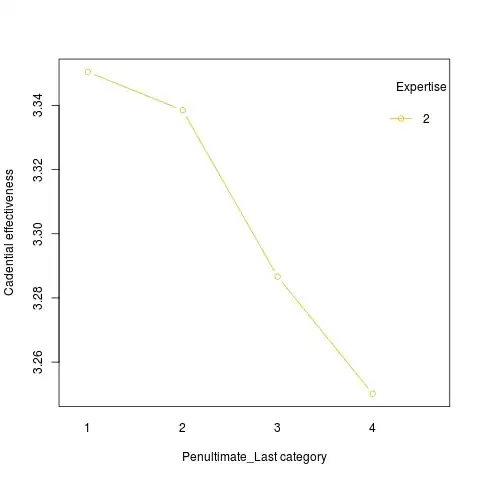I have a lmer model that analyse the interaction between a treatment (4 levels. Name: Relation_PenultimateLast) and 3 groups (ExpertiseType), crossed. In this model I have 3 by-group random effects.
The function used is lmer from the library lme4, extended through the lmerTest library.
Here the formula:
f.e.model = lmer(Score ~ Relation_PenultimateLast*ExpertiseType + (1|TrajectoryType) + (1|StimulusType) + (1|LastPosition), data=datasheet.complete)
Results:
Scaled residuals:
Min 1Q Median 3Q Max
-2.43700 -0.87535 -0.03117 0.76091 2.06034
Random effects:
Groups Name Variance Std.Dev.
TrajectoryType (Intercept) 0.019520 0.13971
LastPosition (Intercept) 0.008778 0.09369
StimulusType (Intercept) 0.028348 0.16837
Residual 1.292387 1.13683
Number of obs: 8200, groups:
TrajectoryType, 25; LastPosition, 8; StimulusType, 4
Fixed effects:
Estimate Std. Error df t value
(Intercept) 3.34934 0.13401 17.00000 24.993
Relation_PenultimateLast -0.08738 0.03453 77.00000 -2.531
ExpertiseType -0.09808 0.03639 8165.00000 -2.695
Relation_PenultimateLast:ExpertiseType 0.05224 0.01271 8165.00000 4.110
Pr(>|t|)
(Intercept) 7.55e-15 ***
Relation_PenultimateLast 0.01343 *
ExpertiseType 0.00705 **
Relation_PenultimateLast:ExpertiseType 3.99e-05 ***
Using the plot function:
f.e.model.plot = datasheet.complete
f.e.model.plot$fit <- predict(f.e.model)
interaction.plot(x.factor = f.e.model.plot$Relation_PenultimateLast, trace.factor = f.e.model.plot$ExpertiseType,
response = f.e.model.plot$fit, fun = mean,
type = "b", legend = TRUE,
fixed=TRUE,
xlab = "Penultimate_Last category", ylab="Cadential effectiveness", trace.label = "Expertise",
pch=c(1,19), col = c("#00AFBB", "#E7B800", "#FF0000")
)
I obtain this graph:
Note the yellow line, ParticipantType = 2
I would expect the yellow line to represent the effects of the treatment within the group 2, but if I run the same analysis mode within the group:
datasheet.complete.performers = subset(datasheet.complete, ExpertiseType==2) #create a subset with only composers
f.e.model.performers = lmer(Score ~ Relation_PenultimateLast + (1|TrajectoryType) + (1|StimulusType) + (1|LastPosition), data=datasheet.complete.performers)
Results:
Scaled residuals:
Min 1Q Median 3Q Max
-2.41905 -0.87678 0.02313 0.76503 1.85794
Random effects:
Groups Name Variance Std.Dev.
TrajectoryType (Intercept) 0.01906 0.1381
LastPosition (Intercept) 0.01179 0.1086
StimulusType (Intercept) 0.06358 0.2522
Residual 1.39162 1.1797
Number of obs: 2400, groups:
TrajectoryType, 25; LastPosition, 8; StimulusType, 4
Fixed effects:
Estimate Std. Error df t value Pr(>|t|)
(Intercept) 3.40381 0.15825 6.70100 21.509 1.96e-07 ***
Relation_PenultimateLast -0.03909 0.03059 23.09500 -1.278 0.214
I obtain a complete different scenario:
f.e.model.performers.plot = datasheet.complete.performers
f.e.model.performers.plot$fit <- predict(f.e.model.performers)
interaction.plot(x.factor = f.e.model.performers.plot$Relation_PenultimateLast, trace.factor = f.e.model.performers.plot$ExpertiseType,
response = f.e.model.performers.plot$fit, fun = mean,
type = "b", legend = TRUE,
fixed=TRUE,
xlab = "Penultimate_Last category", ylab="Cadential effectiveness", trace.label = "Expertise",
pch=c(1,19), col = c("#E7B800"))
Should not the two representation of the effect of Relation_PenultimateLast be the same? Should I consider the second graph the correct representation? Or should this be a warning that there is still some random effect that is not counted in the formula?

